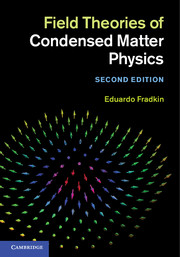Book contents
- Frontmatter
- Contents
- Preface to the second edition
- Preface to the first edition
- 1 Introduction
- 2 The Hubbard model
- 3 The magnetic instability of the Fermi system
- 4 The renormalization group and scaling
- 5 One-dimensional quantum antiferromagnets
- 6 The Luttinger liquid
- 7 Sigma models and topological terms
- 8 Spin-liquid states
- 9 Gauge theory, dimer models, and topological phases
- 10 Chiral spin states and anyons
- 11 Anyon superconductivity
- 12 Topology and the quantum Hall effect
- 13 The fractional quantum Hall effect
- 14 Topological fluids
- 15 Physics at the edge
- 16 Topological insulators
- 17 Quantum entanglement
- References
- Index
3 - The magnetic instability of the Fermi system
Published online by Cambridge University Press: 05 March 2013
- Frontmatter
- Contents
- Preface to the second edition
- Preface to the first edition
- 1 Introduction
- 2 The Hubbard model
- 3 The magnetic instability of the Fermi system
- 4 The renormalization group and scaling
- 5 One-dimensional quantum antiferromagnets
- 6 The Luttinger liquid
- 7 Sigma models and topological terms
- 8 Spin-liquid states
- 9 Gauge theory, dimer models, and topological phases
- 10 Chiral spin states and anyons
- 11 Anyon superconductivity
- 12 Topology and the quantum Hall effect
- 13 The fractional quantum Hall effect
- 14 Topological fluids
- 15 Physics at the edge
- 16 Topological insulators
- 17 Quantum entanglement
- References
- Index
Summary
The Hubbard model was originally introduced as the simplest system which may exhibit an insulating (Mott) state. This state is the result of strong electron–electron interactions. In this chapter we consider the Hubbard model at half-filling. The main goal here is the study of the magnetic properties of its ground state. Apart from an exact solution in one dimension, no exact results are available for this problem. This leads to the use of several approximations. The most popular one, and the oldest, is the mean-field theory (MFT). In the MFT one has the bias that the ground state does have some sort of magnetic order (i.e. ferromagnetic, Néel antiferromagnetic, etc.). The problem is then usually solved by means of a variational ansatz. However, one is usually interested in more than just the ground-state energy, which, after all, is not directly measurable and depends very sensitively on the properties at short distances. Most often we wish to evaluate the long-distance, low-frequency, properties of the correlation and response functions of this theory. Moreover, in some cases, such as in one dimension, the fluctuations overwhelm the MFT predictions.
In this chapter we will consider the standard MFT (i.e. Hartree–Fock), which is expected to become accurate at weak coupling. We will consider both ferromagnetic and antiferromagnetic states. We will also rederive these results using path integrals. As a byproduct, we will also have a theory of the fluctuations: the non-linear sigma model.
- Type
- Chapter
- Information
- Field Theories of Condensed Matter Physics , pp. 27 - 62Publisher: Cambridge University PressPrint publication year: 2013



